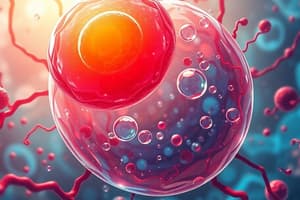Podcast
Questions and Answers
Ernest McCulloch's initial recognition of the significance of an unexpected result from a radiation experiment demonstrates which key scientific trait?
Ernest McCulloch's initial recognition of the significance of an unexpected result from a radiation experiment demonstrates which key scientific trait?
- Collaboration with diverse researchers to validate findings.
- Adherence to established protocols, ensuring reliable data collection.
- Serendipity, where chance encounters lead to unintended discoveries.
- Critical observation and insight, leading to a breakthrough. (correct)
McCulloch's career reflects a commitment to translational medicine. Which sequence of his activities best exemplifies this commitment?
McCulloch's career reflects a commitment to translational medicine. Which sequence of his activities best exemplifies this commitment?
- Working as a research fellow, publishing seminal papers, receiving prestigious awards.
- Analyzing mechanisms of leukemia, directing hematology, working in pathology.
- Studying medicine, joining advisory committees, focusing on leukemia studies.
- Research into blood formation, stem cell research, regenerative medicine. (correct)
What was the primary significance of McCulloch and Till's collaborative work?
What was the primary significance of McCulloch and Till's collaborative work?
- Pioneering the concept of cancer treatment through radiation therapy.
- Establishing the foundational understanding of stem cells. (correct)
- Advancing the understanding of radiation's impact on cellular structures.
- Challenging prevailing theories about the origins of blood disorders.
Considering James Till's transition from physics to cancer research, what broader implication can be drawn about interdisciplinary collaboration in scientific advancement?
Considering James Till's transition from physics to cancer research, what broader implication can be drawn about interdisciplinary collaboration in scientific advancement?
How might McCulloch's involvement with national and international advisory committees have influenced the broader scientific community?
How might McCulloch's involvement with national and international advisory committees have influenced the broader scientific community?
What does McCulloch declining an assistant professorship at Yale in 1957 to work at the University of Toronto indicate about his priorities?
What does McCulloch declining an assistant professorship at Yale in 1957 to work at the University of Toronto indicate about his priorities?
If McCulloch and Till had not discovered stem cells residing in the inner marrow, What is the most logical consequence?
If McCulloch and Till had not discovered stem cells residing in the inner marrow, What is the most logical consequence?
What is the most significant impact of Till's expanded research interests in ethics and patient quality of life?
What is the most significant impact of Till's expanded research interests in ethics and patient quality of life?
How did the Canadian Science and Engineering Hall of Fame induction for both Till and McCulloch reflect their contributions?
How did the Canadian Science and Engineering Hall of Fame induction for both Till and McCulloch reflect their contributions?
How did radiation's use in a medical experiment lead to McCulloch finding a cure for leukemia?
How did radiation's use in a medical experiment lead to McCulloch finding a cure for leukemia?
How did Till and McCulloch determine that each spleen nodule originated from a single cell?
How did Till and McCulloch determine that each spleen nodule originated from a single cell?
What was the primary reason Till and McCulloch initially used radiation in their experiments with mice?
What was the primary reason Till and McCulloch initially used radiation in their experiments with mice?
Why was the discovery that each spleen nodule contained a mix of red blood cells, white blood cells, and platelets particularly significant?
Why was the discovery that each spleen nodule contained a mix of red blood cells, white blood cells, and platelets particularly significant?
How did Yamanaka's work on induced pluripotent stem cells (iPS cells) build upon the earlier discoveries of Till and McCulloch?
How did Yamanaka's work on induced pluripotent stem cells (iPS cells) build upon the earlier discoveries of Till and McCulloch?
What critical technical advancement enabled Till and McCulloch to quantify the number of surviving donor cells in the recipient mice?
What critical technical advancement enabled Till and McCulloch to quantify the number of surviving donor cells in the recipient mice?
Considering the role of serendipity in Till and McCulloch's discovery, what best illustrates the scientific community's initial reaction to their 'unexpected findings'?
Considering the role of serendipity in Till and McCulloch's discovery, what best illustrates the scientific community's initial reaction to their 'unexpected findings'?
In the context of Till and McCulloch's research, what differentiates a 'colony-forming unit' from a differentiated blood cell?
In the context of Till and McCulloch's research, what differentiates a 'colony-forming unit' from a differentiated blood cell?
Given the ethical considerations surrounding the use of radiation in research, what control measures were most likely implemented in Till and McCulloch's experiments?
Given the ethical considerations surrounding the use of radiation in research, what control measures were most likely implemented in Till and McCulloch's experiments?
What long-term impact of Till and McCulloch's work extends beyond the specific field of hematology and stem cell research?
What long-term impact of Till and McCulloch's work extends beyond the specific field of hematology and stem cell research?
How did the use of bone marrow transplantation as a treatment at the time of Till and McCulloch's experiments influence their research design?
How did the use of bone marrow transplantation as a treatment at the time of Till and McCulloch's experiments influence their research design?
Flashcards
Who was Ernest McCulloch?
Who was Ernest McCulloch?
A hematologist who dreamed of finding a cure for leukemia and co-discovered stem cells.
Ontario Cancer Institute
Ontario Cancer Institute
In 1957, McCulloch joined the newly created Ontario Cancer Institute.
Stem Cell Potential
Stem Cell Potential
Stem cells can transform cancer research and give rise to regenerative medicine.
Pivotal Publication (1963)
Pivotal Publication (1963)
Signup and view all the flashcards
Seminal Paper (1961)
Seminal Paper (1961)
Signup and view all the flashcards
Discovery by McCulloch and Till
Discovery by McCulloch and Till
Signup and view all the flashcards
Who was James Till?
Who was James Till?
Signup and view all the flashcards
What are stem cells?
What are stem cells?
Signup and view all the flashcards
Bone marrow transplantation
Bone marrow transplantation
Signup and view all the flashcards
McCulloch's Observation
McCulloch's Observation
Signup and view all the flashcards
Nodule Composition
Nodule Composition
Signup and view all the flashcards
Colony Cell Types
Colony Cell Types
Signup and view all the flashcards
Yamanaka's Reprogramming
Yamanaka's Reprogramming
Signup and view all the flashcards
What does pluripotent mean?
What does pluripotent mean?
Signup and view all the flashcards
Study Notes
- McCulloch and Till's combination of skills in cellular biology and biophysics proved powerful.
- In 1961, while researching bone marrow cells, McCulloch and Till discovered the first clue to the existence of stem cells.
- Stem cells have a unique potential to become other, specialized types of cells, and can also self-renew and multiply.
- McCulloch described the discovery as a case study in "the importance of serendipity in scientific research."
- McCulloch was interested in the medical potential of nuclear radiation and wanted to explore its effects on cancer cells.
- McCulloch's project involved irradiating mice.
- McCulloch, a medical doctor, needed Till, a physicist, with the necessary expertise in radiation.
- The two began measuring the radiation sensitivity of the mice's bone marrow cells.
- Mice were exposed to lethal radiation and then had their bone marrow cells replaced with donor cells.
- Bone marrow transplantation was a new treatment known to replenish crucial blood cells.
- Till and McCulloch exposed the donor marrow in their transplants to varying doses of radiation.
- The scientists measured how many donor cells survived the radiation doses by monitoring the mice’s response.
- The team repeated the experiment and carried out autopsies on the mice 10 days after the transplants.
- One Sunday morning, McCulloch assessed tissue samples from the autopsies.
- McCulloch saw a number of small bumps on the dead mice’s spleens.
- The number of spleen bumps, or nodules, was in direct proportion to the number of live marrow cells the mice had received.
- Till and McCulloch needed to find out whether each of these nodules had grown from a single cell or from many cells.
- Till and McCulloch, with Till's PhD student Andrew Becker, irradiated the donor cells to create a marker or trace.
- Radiation caused small changes to the chromosomes in a few of the irradiated donor cells.
- Altered chromosomes acted as a marker, present in any new cells that had grown from them.
- After isolating and examining hundreds of cells from a new set of spleen nodules, the team found that each nodule had grown from a single cell, meaning they were clones.
- Till and McCulloch referred to the original cells as "colony-forming units."
- The colonies of cells in each nodule were a mixture of those that develop into the three types of blood cells: red cells, white cells, and platelets.
- Till and McCulloch published their findings in 1961 in a paper that referred to the "radiation sensitivity of normal mouse bone marrow cells," which was largely ignored.
- In 1963, Till, McCulloch, and Becker published further results in Nature, which gained attention.
- Subsequent studies showed that bone marrow contains special cells that can reproduce and develop into other types of cells, with specialized functions.
- Adult stem cells exist in many organs and tissues and help the body heal or regenerate damaged tissue.
- Discovery was a vital advance in biological science and has huge potential for treating disease.
- After the marrow transplants, the mice were examined for 10 to 11 days.
- Each mouse spleen nodule corresponded to 10,000 bone marrow cells.
- Stem cell research accelerated the development of bone marrow transplants.
Shinya Yamanaka
- Yamanaka reprogrammed mature cells and was able to turn them back into stem cells.
- In 2006, Yamanaka introduced 24 specific genes into adult skin cells in mice, reverting them to an immature stem-cell state.
- Yamanaka showed that these cells were pluripotent, meaning they can become any type of cell.
- Previously, it was thought that only embryonic stem cells were pluripotent.
- Yamanaka jointly received the Nobel Prize in Physiology or Medicine in 2012 for his work.
Studying That Suits You
Use AI to generate personalized quizzes and flashcards to suit your learning preferences.





